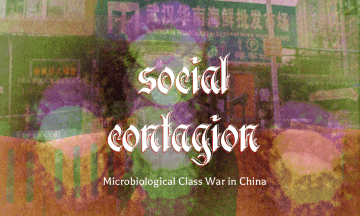From Chuang:
 Wuhan is known colloquially as one of the “four furnaces” (四大火炉) of China for its oppressively hot humid summer, shared with Chongqing, Nanjing and alternately Nanchang or Changsha, all bustling cities with long histories along or near the Yangtze river valley. Of the four, Wuhan, however, is also sprinkled with literal furnaces: the massive urban complex acts as a sort of nucleus for the steel, concrete and other construction-related industries of China, its landscape dotted with the slowly-cooling blast furnaces of the remnant state-owned iron and steel foundries, now plagued by overproduction and forced into a contentious new round of downsizing, privatization and general restructuring—itself resulting in several large strikes and protests in the last five years. The city is essentially the construction capital of China, which means it has played a particularly important role in the period after the global economic crisis, since these were the years in which Chinese growth was buoyed by the funneling of investment funds into infrastructure and real estate projects. Wuhan not only fed this bubble with its oversupply of building materials and civil engineers but also, in so doing, became a real estate boomtown of its own. According to our own calculations, in 2018-2019 the total area dedicated to construction sites in Wuhan was equivalent to the size of Hong Kong island as a whole.
Wuhan is known colloquially as one of the “four furnaces” (四大火炉) of China for its oppressively hot humid summer, shared with Chongqing, Nanjing and alternately Nanchang or Changsha, all bustling cities with long histories along or near the Yangtze river valley. Of the four, Wuhan, however, is also sprinkled with literal furnaces: the massive urban complex acts as a sort of nucleus for the steel, concrete and other construction-related industries of China, its landscape dotted with the slowly-cooling blast furnaces of the remnant state-owned iron and steel foundries, now plagued by overproduction and forced into a contentious new round of downsizing, privatization and general restructuring—itself resulting in several large strikes and protests in the last five years. The city is essentially the construction capital of China, which means it has played a particularly important role in the period after the global economic crisis, since these were the years in which Chinese growth was buoyed by the funneling of investment funds into infrastructure and real estate projects. Wuhan not only fed this bubble with its oversupply of building materials and civil engineers but also, in so doing, became a real estate boomtown of its own. According to our own calculations, in 2018-2019 the total area dedicated to construction sites in Wuhan was equivalent to the size of Hong Kong island as a whole.
But now this furnace driving the post-crisis Chinese economy seems, much like those found in its iron and steel foundries, to be cooling. Though this process was already well underway, the metaphor is now no longer simply economic, either, as the once-bustling city has been sealed off for over a month, its streets emptied by government mandate: “The greatest contribution you can make is: don’t gather together, don’t cause chaos,” read a headline in the Guangming Daily, run by the Chinese Communist Party’s propaganda department. Today the Wuhan’s broad new avenues and the glittering steel and glass buildings that crown them are all cold and hollow, as winter dwindles through the Lunar New Year and the city stagnates under the constriction of the wide-ranging quarantine.
More here.
